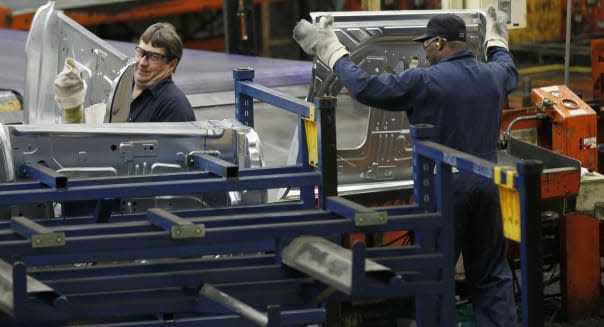U.S. Third-Quarter Economic Growth Revised Upward to 3.6%

By Lucia Mutikani
WASHINGTON -- The U.S. economy grew faster than initially estimated in the third quarter as businesses aggressively accumulated stock, but underlying domestic demand remained sluggish and buoyed the case for the Federal Reserve to keep up its stimulus for now.
Gross domestic product grew at a 3.6 percent annual rate instead of the 2.8 percent pace reported earlier, the Commerce Department said Thursday. Economists polled by Reuters had expected output would be revised up to only a 3.0 percent rate.
The third-quarter growth pace was the fastest since the first quarter of 2012 and marked an acceleration from the April-June period's 2.5 percent rate, although economists expect slower growth in the final months of the year.
Businesses accumulated $116.5 billion worth of inventories, the largest increase since the first quarter of 1998. That compared to prior estimates of only $86 billion.
"To the extent that the massive accumulation in inventory may have been involuntary, we are likely to see an unwind in inventory this quarter which will provide some downside risks to fourth-quarter GDP performance," said Millan Mulraine, senior economist at TD Securities (TD) in New York.
Inventories accounted for a massive 1.68 percentage points of the advance made in the July-September quarter, the largest contribution since the fourth quarter of 2011. %VIRTUAL-article-sponsoredlinks%The contribution from inventories had previously been estimated at 0.8 percentage point. Stripping out inventories, the economy grew at a 1.9 percent rate.
But a gauge of domestic demand rose at just a 1.8 percent rate -- probably insufficient to convince the U.S. central bank to trim its bond purchases in December. The Fed has been buying $85 billion in bonds each month to keep borrowing costs low but officials have said they may start to slow these in coming months.
Atlanta Federal Reserve President Dennis Lockhart, who doesn't have a vote on the policymaking committee this year or next, said one strong quarter didn't make a trend. "I am not prepared to interpret the revised third quarter number as an indication that the economy is on a much stronger track -- I think we're still on that relatively moderate growth track," Lockhart said.
The strong inventory accumulation in the face of a slowdown in domestic demand means businesses will need to draw down on stocks, which will weigh on GDP growth this quarter.
Fourth quarter growth estimates are already on the low side, with a 16-day shutdown of the government in October expected to shave off as much as half a percentage point from GDP. Fourth-quarter growth estimates are currently below a 2 percent rate.
U.S. stocks opened lower and prices for Treasuries were down in morning trade.
Consumers Cautious
Consumer spending, which accounts for more than two-thirds of U.S. economic activity, was revised down to a 1.4 percent rate, the lowest since the fourth quarter of 2009. Spending had previously been estimated to have increased at a 1.5 percent pace, and grew at a 1.8 percent rate in the April-June period.
But there is reason to be cautiously optimistic about future consumption, despite a generally weak opening to the holiday shopping season last month.
A separate report from the Labor Department showed initial claims for state unemployment benefits dropped 23,000 to a seasonally adjusted 298,000 last week.
That was the third straight week of declines and confounded economists' expectations for an increase to 325,000. The four-week moving average for new claims, which irons out week-to-week volatility, fell 10,750 to 322,250.
Coming on the heels of a report Wednesday showing a pickup in private sector hiring, the claims report suggested the labor market is gaining momentum.
The government is expected to report on Friday that nonfarm payrolls increased 180,000 last month and the unemployment rate fell to 7.2 percent from 7.3 percent, according to a Reuters survey of economists.
The GDP report showed upward revisions to business spending, but estimates for residential construction were lowered. The trade deficit was larger than previously estimated, resulting in trade being neutral to growth in the third quarter.
The Commerce Department also reported that corporate profits after tax increased at a 2.6 percent pace in the third quarter, slowing from the prior quarter's 3.5 percent pace.
A second report from the Commerce Department showed orders for manufactured goods dropped 0.9 percent in October after rising 1.8 percent in September.
But orders for non-defense capital goods, excluding aircraft -- seen as a measure of business confidence and spending plans -- slipped 0.6 percent in October instead of the 1.2 percent fall reported last week.
